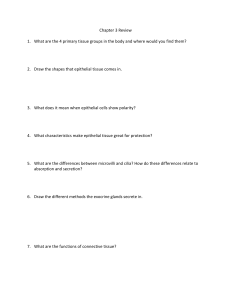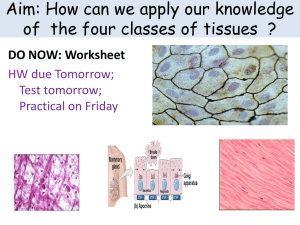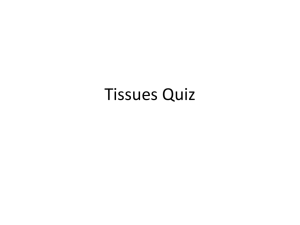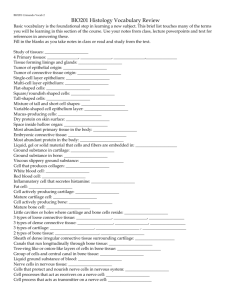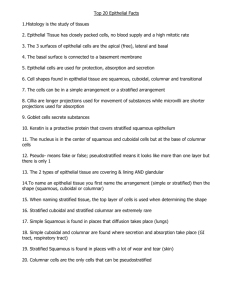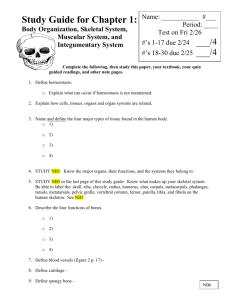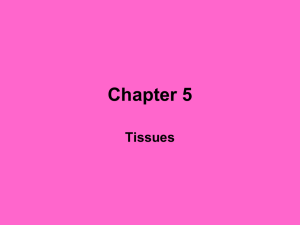Anatomy - WSHSAnatomy
advertisement
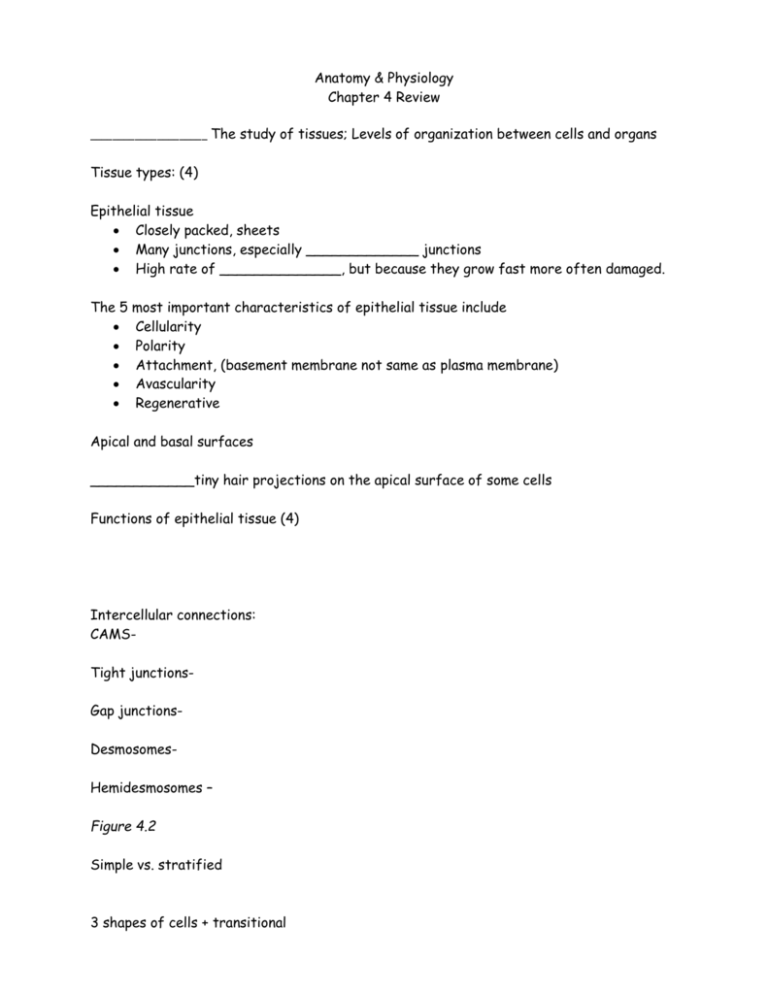
Anatomy & Physiology Chapter 4 Review _____________________ The study of tissues; Levels of organization between cells and organs Tissue types: (4) Epithelial tissue Closely packed, sheets Many junctions, especially _____________ junctions High rate of ______________, but because they grow fast more often damaged. The 5 most important characteristics of epithelial tissue include Cellularity Polarity Attachment, (basement membrane not same as plasma membrane) Avascularity Regenerative Apical and basal surfaces ____________tiny hair projections on the apical surface of some cells Functions of epithelial tissue (4) Intercellular connections: CAMSTight junctionsGap junctionsDesmosomesHemidesmosomes – Figure 4.2 Simple vs. stratified 3 shapes of cells + transitional Table 4.1 Simple Squamous- flat, ________ layer thick, allows for quick diffusion Examples allowing drug diffusion _________________ line the inside of blood vessels and heart, IV injections Lung alveoli Anesthetic inhalation _________________ line the ventral body cavitity, IP injections (intraperitoneal) Simple cuboidal – single layer, __________-shaped cells Nuclei appear _______ Function: secretion and __________________ Example: _________________ tubules Simple Columnar – single layer, _____________________ cells Nuclei sometimes _________ May have ______________, finger-like projections on the apical surface May secrete mucus (goblet cells) Pseudostratified Actually only __________ layer ______________ are at different heights, all cells touch ______________ membrane May have ______________ on the apical surface Stratified squamous Major function - _________ Examples include: Stratified cuboidal Major function – secretion In ___________ of exocrine ______________, e.g. salivary, sweat, mammary Stratified columnar Rare, function: secretion and ________________ Transitional epithelium _____________ which allows changes in cell shape Located: Endocrine glands ReleasedSecretions called - Which - Ducts/ductless Exocrine glands Released – Which – ducts/ductless Modes of secretion Merocrine Apocrine Holocrine Types of secretion Serous Mucous Mixed Connective Tissue Most abundant, scattered cells, rarely touch 3 Basic components Specialized cells Extracellular protein fiber Ground substance – Extracellular matrix – Fills space Fluid (blood) Semifluid (adipose tissue) Fibrous (dense regular tissue) Calcified (bone) Many conn. tissue are highly _______________ (have a blood supply) with the exception of tendons/ligaments/cartilage Connective tissue cells Immature =blast, mature = cyte Fixed cells: Fibroblasts Most common CT cells Large, flat, branched Form matrix Make ________________ Adipocytes Fat cells Contain a ____________________ droplet (triglyceride) Expandable Found in _______, greater _________________ Macrophages (fixed or wandering) Garbage workers of the body o Eat foreign matter by the process of ___________________ Wandering cells: Macrophages – reinforce the fixed macrophages Leukocytes (WBC) Lymphocytes develop into _________________ & make ________________ Mast cells contain ___________ & ________________ to stimulate local inflammation Melanocytes Synthesize and store ____________________ Adipose tissue: Provides: Found where? Difference between white and brown fat Dense connective tissue: Difference between tendons and ligaments Cartilage Cells called ____________ Avascular 3 types of cartilage Hyaline o Most abundant type o Smooth, hard, flexile, (gristle) o Ends of bones, Adam’s apple, Fibrocartilage o Few cells, mostly fibers o Function=support and fusion o Between spinal vertebrae, pubic bones of the pelvis Elastic o High concentration of chondrocytes o Function: support and flexibility o External ear, epiglottis, larynx Bone Bone cells = ____________________ Blood Part of the vascular tiussue Liquid matrix with no fibers o Erythrocytes o Leukocytes o Platelets Muscle Tissue Skeletal o Connects bones (movement) o Striated o Parallel fibers (pulling part of one bone to part of another bone in one direction) o Multinucleated = o voluntary
